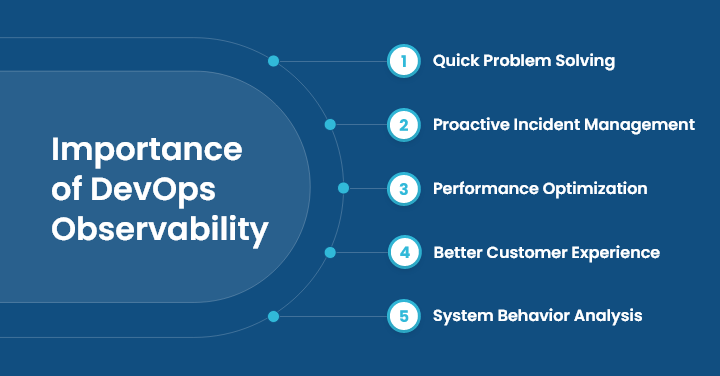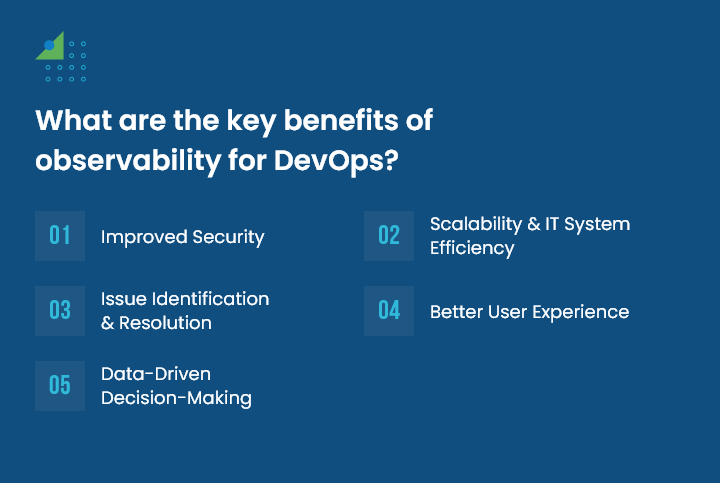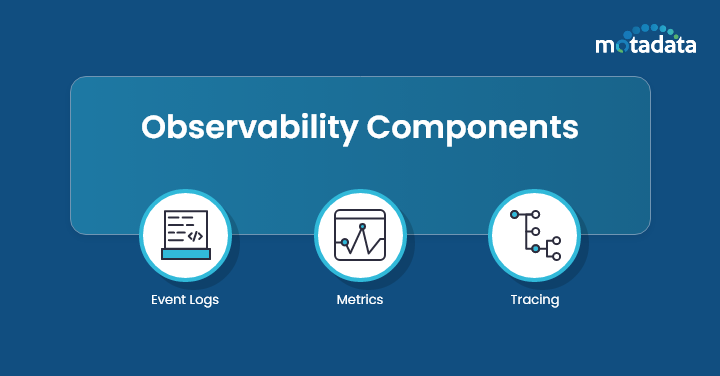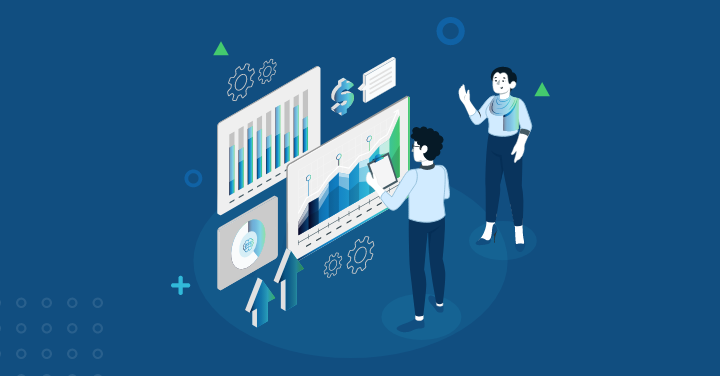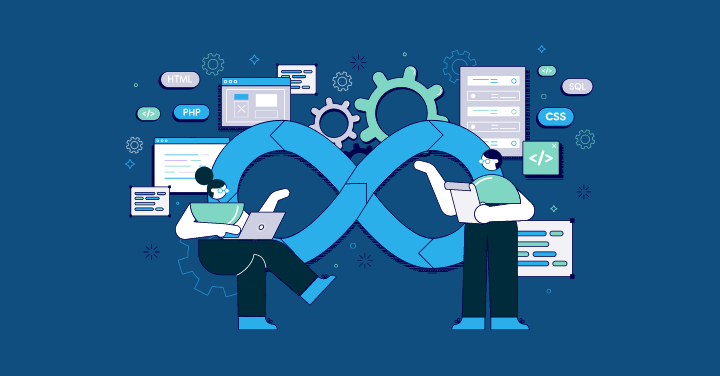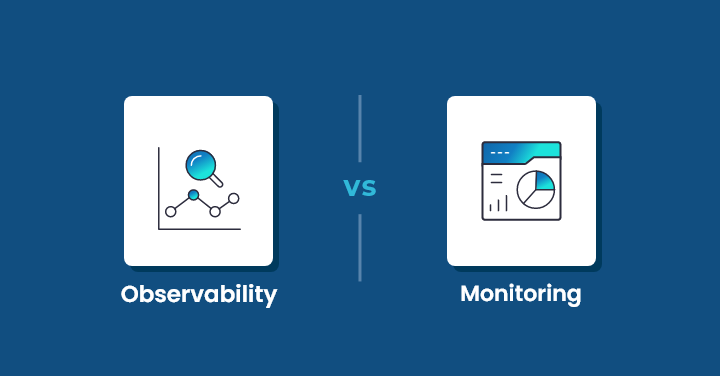In today’s competitive world, each business wants to stand out and accordingly demands changes and developments in its products and software.
In some cases, clients request the addition of new functionalities, whereas, in other instances, they demand for the creation of new code.
DevOps can make these changes quickly with the right tools and practices but there is more to it that must be taken care of – Observability.
Observability provides detailed insights into the system’s behavior and performance by analyzing external outputs, key performance indicators, log data, and traces.
It helps DevOps teams to discover and address issues before they affect the end-user experience.
With Observability in DevOps processes, software engineers can gain better visibility into the ongoing processes in the application, and understand the root cause of the problem. and improve overall IT operations.
Let us learn more about the concept of DevOps observability, its importance, and its key benefits in detail.
What is Observability in DevOps?
There’s no mean of monitoring without having Observability in the first place.
As per the definition, a system is only observable if you can estimate the system’s current state with the available output information.
The DevOps team is supposed to communicate efficiently to improve the visibility across the CI/CD pipelines.
Continuous improvement is what the DevOps team intends to achieve at any given moment.
Observability in DevOps is a technical solution that helps IT firms understand the ongoing processes in the application with the help of the application’s output.
It makes firms understand the problems occurring in the applications and pinpoints how, what, why, and where the application is malfunctioning with rich insights.
The Observability can be helpful to SREs (Site Reliability Engineers) for the given points below.
- Offering high-quality applications and software with scale
- Accessibility across the performances and digital assets
- Building sustainable, innovative environments
- Maximizing the organizational investments into the cloud and other tools
- Investigating root causes faster and resolving in minimum time
Why does your organization need DevOps observability?
Many IT businesses rely on Application Performance Monitoring (APM) for tracking and optimizing the performance of their applications.
These tools collect insights and perform analysis on telemetry data to prevent potential problems and resolve them before they escalate.
However, APM is a great option only for the traditional distributed applications as they have known dependencies and workflows which makes it easy to identify issues.
But, today things have changed and become more advanced. With the rise in digital technologies, the distributed nature of applications has become more complex.
In order to provide apps faster than ever before, many organizations are utilizing DevOps approaches.
Basically, in order to generate comprehensive information on each application, the DevOps ecosystem requires high-quality telemetry data.
To obtain great visibility of their intricate application ecosystem, comprehend any change—planned or unplanned—and remain ahead of the curve, enterprises must therefore use DevOps observability.
Importance of DevOps Observability
With more and more businesses adopting digital technologies, system complexities, and customer expectations are rising.
Observability for DevOps is a great approach in this case for it helps understand operation and the internal state of your system.
With actionable insights, software engineers can promptly resolve issues and improve user experience.
Here are a few more reasons why DevOps observability has become a critical aspect of software development.
1. Quick Problem Solving
DevOps teams can quickly identify the root cause of the problem, understand the issue, and resolve it in real-time with a robust observability setup.
The insights collected from several sources, such as log files and key performance metrics can further help in reducing Mean-Time-To-Resolution (MTTR).
2. Proactive Incident Management
With observability data, team members can keep track of all trends and patterns in real-time and prevent minor issues from turning into big problems and affecting end users.
Further, this approach helps increase the uptime and system reliability that aids in incident management.
3. Performance Optimization
The proactive approach enables team members to track the changes and understand how it is impacting the overall performance of your system.
With this greater insight, Ops teams can make better decisions related to resource usage and system performance.
4. Better Customer Experience
Fewer downtimes, faster issue resolution, enhanced performance delivery, and other factors are what customers look for when investing in a product or software.
With observability, organizations can detect and resolve potential issues at an initial stage which contributes to an improved customer experience.
5. System Behavior Analysis
With Observability, engineers can gain in-depth insights into the application and view how different parts work together.
In today’s distributed systems where data is so complex, understanding the system behavior can be quite challenging without the right technique and approach.
However, observability makes the whole process smooth and easy.
What are the key benefits of observability for DevOps?
Development teams can gain valuable insights into system behavior with the help of comprehensive observability metrics, facilitating ongoing development and reduced MTTR.
Here are a few more benefits of embracing observability practices:
1. Improved Security
Observability has an indirect positive impact on security by facilitating security event identification and response, even though this is not a direct advantage.
DevOps teams can spot possible security vulnerabilities and take preventative action in real-time.
The observability platform helps the DevOps team to keep an eye on system behavior and examine unusual trends.
On detecting anything suspicious, the tool immediately sends an alert to the engineers updating them about the problem.
2. Scalability and IT System Efficiency
With the help of this robust approach, DevOps teams may scale their applications and infrastructure more effectively and meet the unique needs of customers.
Engineers may ensure cost-effective scalability by planning for future capacity demands, optimizing resource allocation, and right-sizing deployments by monitoring workload trends and resource use patterns.
3. Issue Identification and Resolution
DevOps engineers can quickly find out the root cause of the potential problem thanks to the observability tools.
With the help of comprehensive insights collected by the tool, teams can resolve the problem in real-time and minimize downtime as well as reduce MTTR.
4. Better User Experience
The observability tool also provides clear visibility into the system performance and user interactions which gives a better understanding of end-user experience.
It provides detailed information on performance bottlenecks and usability problems that once fixed will help deliver a better experience and improved user retention count.
5. Data-Driven Decision-Making
Observability helps businesses gather all the data from different sources related to the system performance and errors which are later used for making informed decisions.
These insights and decisions further help in improving reliability and user experience.
The Observability Components
There are three essential components to Observability. With each element, your monitoring practice gets more robust and profound.
They are like building blocks. Here’s a brief introduction to each and its importance.
- Event Logs: Event logs describe discrete events with time stamps. SREs pay their attention to Logs to know about the failures and issues. With historical data of the events and failures, SREs get the context, making it easy to resolve the problems.
- Metrics: A metric is data measurements over intervals of time. It has a set of traits like time stamp, name, value, and label. An SRE uses metrics to trigger an alert whenever a number rises above the set threshold. Metrics help you define the key areas, Service Level Agreements (SLAs), Service Level Objectives (SLOs), and Service Level Indicators (SLIs).
- Tracing: Traces represent a span of executed code with three attributes, name, ID, and time value. By combining traces from any distributed system, you can see an end-to-end flow and executed path. In addition, they discover the area where codes are taking more time to get completed.
Conclusion
In DevOps, observability is essential for promptly detecting and fixing problems, enhancing system performance, and providing improved client experiences.
By putting observability strategies into practice, you may proactively monitor and troubleshoot all issues.
The tool provides real-time insights into the system’s IT operations, application performance, and infrastructure that further help in informed decision-making.
By identifying trends, abnormalities, and possible bottlenecks, observability enables you to optimize your DevOps operations and improve customer satisfaction.
There are several trusted observability tools in the market like Motadata on which you can rely and deliver high-quality, reliable software.
It creates a culture of continual improvement and facilitates team collaboration.
By using observability, your company can fulfill client expectations, stay ahead of the curve, and provide high-quality products and services.
Unleash the full potential of your DevOps techniques by embracing observability and overcoming any obstacles.
FAQs
Observability in DevOps refers to the ability to provide detailed insights into the system performance for a better understanding of system behavior.
The practice helps analyze the outputs and other information collected from different sources, including log frameworks, specific metrics, and monitoring systems.
In simple terms, operations teams can produce software more quickly when they can detect and fix problems more quickly thanks to observability.
Logs, metrics, and distributed traces are the three main key pillars of observability in DevOps. Logs are plain text records that include all information related to daily operations and events that take place within an organization, Metrics are referred to as quantitative data related to system performance and operations.
This enables teams and developers working in DevOps to identify specific patterns in the system’s performance. Lastly, the distributed traces display the entire path of a request that is passed within a system.
Firstly, you must update and educate your team members on the importance of observability and how it can impact your user experience,
You run training programs, workshops, and online courses or provide resources to guide about monitoring tools and distributed tracing,
It is also essential to encourage collaboration and share information with other team members.
Additionally, review observability procedures frequently to determine how well they are working for the team.
The progress made in automation, AI, and ML technologies will determine the direction of DevOps observability in the future.
The use of AI/ML algorithms in observability solutions will help team members automatically detect anomalies, perform predictive analytics, and quick issue resolution is something we should anticipate seeing expand.
Furthermore, observability technologies will prioritize proactive monitoring by becoming more integrated with other DevOps tools and processes.
Moreover, as enterprises adopt microservices and cloud-native architectures, observability tools will advance to accommodate the complexity of these settings, offering a more in-depth understanding of distributed systems and containerized applications.


